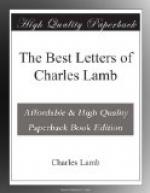“Mr. Lamb’s first appearance was not prepossessing. His figure was small and mean, and no man was certainly ever less beholden to his tailor. His ‘bran’ new suit of black cloth (in which he affected several times during the day to take great pride, and to cherish as a novelty that he had looked for and wanted) was drolly contrasted with his very rusty silk stockings, shown from his knees, and his much too large, thick shoes, without polish. His shirt rejoiced in a wide, ill-plaited frill, and his very small, tight, white neckcloth was hemmed to a fine point at the ends that formed part of a little bow. His hair was black and sleek, but not formal, and his face the gravest I ever saw, but indicating great intellect, and resembling very much the portraits of Charles I.”
From this sprightly and not too flattering sketch we may turn to Serjeant Talfourd’s tender and charming portrait,—slightly idealized, no doubt; for the man of the coif held a brief for his friend, and was a poet besides:—
“Methinks I see him before me now as he appeared then, and as he continued without any perceptible alteration to me, during the twenty years of intimacy which followed, and were closed by his death. A light frame, so fragile that it seemed as if a breath would overthrow it, clad in clerk-like black, was surmounted by a head of form and expression the most noble and sweet. His black hair curled crisply about an expanded forehead; his eyes, softly brown, twinkled with varying expression, though the prevalent expression was sad; and the nose, slightly curved, and delicately carved at the nostril, with the lower outline of the face delicately oval, completed a head which was finely placed upon the shoulders, and gave importance and even dignity to a diminutive and shadowy stem. Who shall describe his countenance, catch its quivering sweetness, and fix it forever in words? There are none, alas! to answer the vain desire of friendship. Deep thought, striving with humor; the lines of suffering wreathed into cordial mirth, and a smile of painful sweetness, present an image to the mind it can as little describe as lose. His personal appearance and manner are not unjustly characterized by what he himself says in one of his letters to Manning, [1] ‘a compound of the Jew, the gentleman, and the angel.’”
The writings of Charles Lamb abound in passages of autobiography. “I was born,” he tells us in that delightful sketch, “The Old Benchers of the Inner Temple,” “and passed the first seven years of my life in the Temple. Its church, its halls, its gardens, its fountain, its river, I had almost said,—for in those young years what was this king of rivers to me but a stream that watered our pleasant places?—these are of my oldest recollections.” His father, John Lamb, the “Lovel” of the essay cited, had come up a little boy from Lincolnshire to enter the service of Samuel Salt,—one of those “Old Benchers” upon whom the pen of Elia has shed immortality, a stanch friend and patron to the Lambs, the kind proprietor of that “spacious closet of good old English reading” upon whose “fair and wholesome pasturage” Charles and his sister, as children, “browsed at will.”




